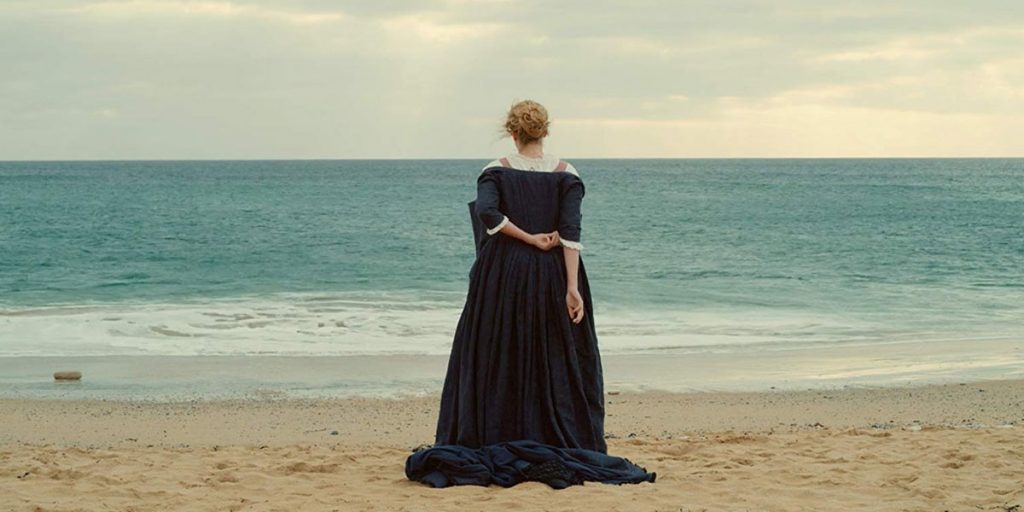In Portrait of a Lady on Fire, director Céline Sciamma teaches us a lesson in love and embroiders a superbly complex piece of dramatic tapestry.
Let me be honest with you: I don’t really know how to start this review. Here’s why: I’ve just seen a film I really liked, and that moved me deeply. I wet my cheeks watching a baby do what babies are supposed to do: roll on their backs like pool-eyed sausages gently grasping for everything that falls within hand’s reach. I went through the credits of Portrait of a Lady on Fire (Portrait de la jeune fille en feu) and I don’t know how to cope with the sterility of my grim daily routine anymore.
There are many different kinds of love. There’s filial or parental love, absence of love – which is hate. Dull sublunary lovers’ love. Poets’ love. Self-love. Carnal love. But, no matter how rich the offer, according to director and screenwriter Céline Sciamma, every kind of love is born in the eyes, and from these raptured eyes it spreads to every inch of the body, clawing it in a seizure of warmth. Therefore, the gaze is paramount, and staring at something – as we eager cinema goers not-so-stereotypically do – is an act of holy devotion.
And “devoted” (to each other, of course) seems to be the perfect word to describe the relationship between painter Marianne (Noémie Merlant, of TÁR) and young ex-nunnery novice Héloïse (Adèle Haenel), who meet in an 18th-century French countryside villa as Marianne is entrusted by Héloïse mother (Valeria Golino) with the painting of her daughter’s portrait. The painting is meant to serve as a token of love for a well-off Milanese gentleman, whom the mother hopes will soon become Héloïse’s husband. There’s a problem, though: Héloïse has just been taken home from the nunnery after her sister’s mysterious death, and she is in no mood to consider marrying a stranger.

Marianne’s mission thus becomes painting Héloïse’s portrait without her noticing. Soon enough, though, Marianne’s silent and obsessive gazes arouse Héloïse’s suspicions, setting up a play of mirrors linking the two characters’ very souls. As declared by Sciamma in the film’s opening sequence, looking means being looked at, and the director takes upon herself the challenge of defying the supremacy of the shallow gaze, championing the almost unbearably intimate power of the loving, and knowing, gaze. Sciamma scuba-dives the bowels of human emotions. And, to make sure her film hits its target right in the middle, she sketches, sketches, and sketches again, until all details are put into place and Portrait of a Lady on Fire feels like a Rembrandt’s – if the Old Master had painted en plein air: gloriously shadowy and in perpetual motion, so that the light can shine brighter.
Nevertheless, oil-on-canvasy as it is, Sciamma (i.e. Claire Mathon’s)’s cinematography isn’t the most heavenly bit of Portrait of a Lady on Fire. What really makes us crave for more is the remarkable writing feat behind it all, which deservedly earned the film a Palme d’Or at Cannes for Best Screenplay. Sciamma writes her scenes passionately and designs her characters from the inside out, infusing them with something that only women, thanks to their natural potential-to-motherhood, instinctually know: the ability to love, and to make that love blaze in gestures, bodies, and words.
So, in a sense, yes, there’s something unique about a woman filmmaker’s gaze, but I can’t really pin that down in words. You’ll have to see for yourselves. As for myself, I’ve never felt more cradled while watching a film, or more excited in realising that what I was so hugely enjoying had nothing to do with sexual voyeurism or ideological feminism. Portrait of a Lady on Fire is just a film; a film like any other. It’s a good film though, a damn good film.
Portrait of a Lady on Fire is now available to watch on digital and on demand.

